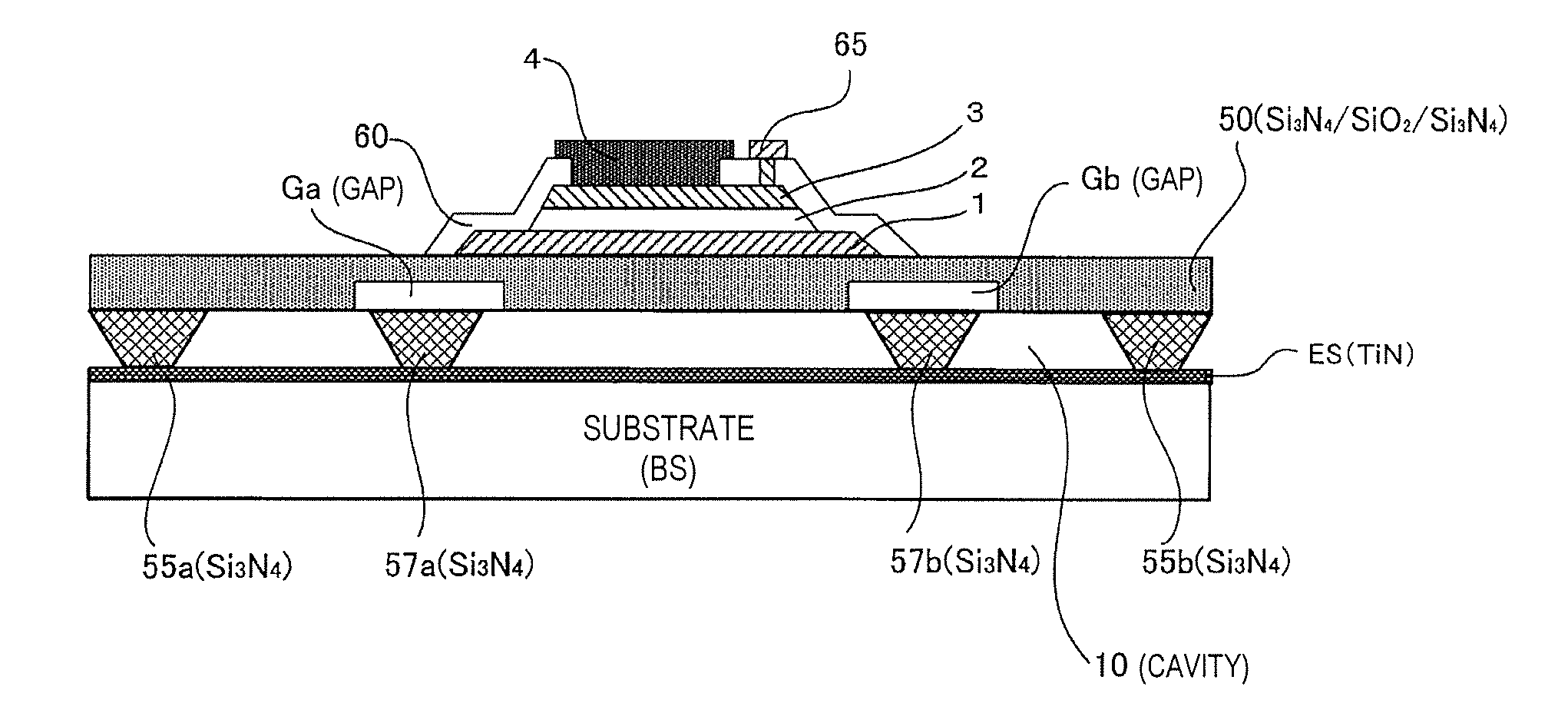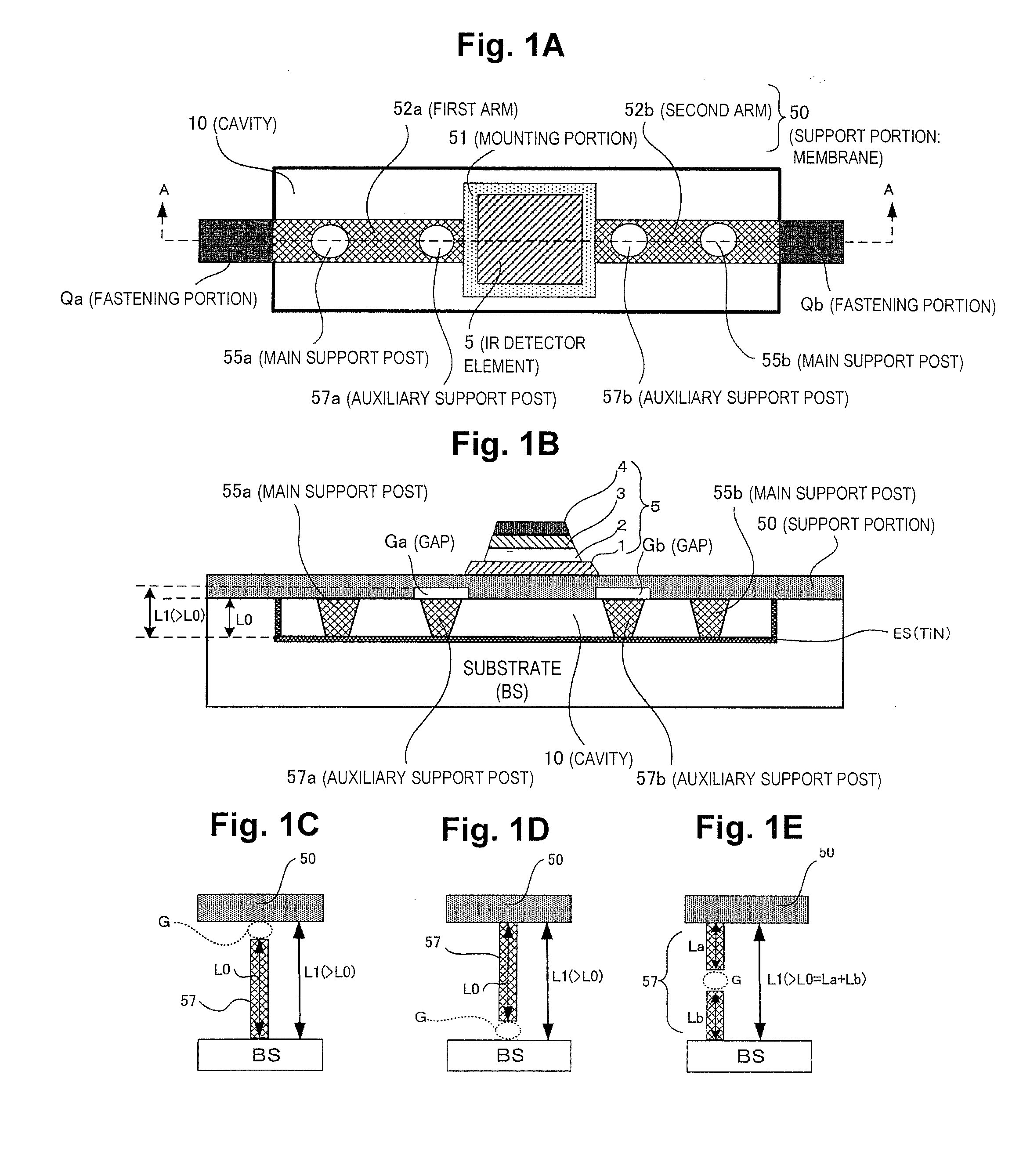Thermal detector, thermal detector device, electronic instrument, and method of manufacturing thermal detector
a technology of thermal detector and support member, which is applied in the direction of optical radiation measurement, instruments, coatings, etc., can solve the problems of high temperature, high temperature, and high temperature of the support member, and achieve the effect of reducing the thermal capacity of the support member
- Summary
- Abstract
- Description
- Claims
- Application Information
AI Technical Summary
Benefits of technology
Problems solved by technology
Method used
Image
Examples
first embodiment
[0054]FIG. 1A to FIG. 1E are drawings illustrating a configuration of an example of a thermal detector (here, a pyroelectric type infrared detector) having auxiliary support posts. FIG. 1A is a plan view of principal portions of the thermal detector; FIG. 1B is a cross-sectional view taken along line A-A in FIG. 1A; and FIG. 1C to FIG. 1E are respectively drawings showing configuration examples of auxiliary support posts.
[0055]The thermal detector shown in FIG. 1A and FIG. 1B is a pyroelectric type infrared detector (pyroelectric type infrared sensor) having a three-dimensional structure formed on a substrate using MEMS (Micro-Electrical-Mechanical Systems) technology (a semiconductor manufacturing technology).
Pyroelectric Type Photodetector Configuration Example
[0056]As shown in FIG. 1A and FIG. 1B, a cavity 10 is provided between the substrate BS and the support member 50. The cavity 10 has a function, for example, of thermally separating the substrate BS from portions of the supp...
second embodiment
[0088]The present embodiment describes an example of preferred placement of auxiliary support posts (and main support posts). FIG. 6A and FIG. 6B are drawings illustrating an example of preferred placement of auxiliary support posts (and main support posts). In FIG. 6A and FIG. 6B, sections common to previous drawings are assigned like reference symbols.
[0089]If a structure whereby support posts are simply provided to support the support member 50 is adopted, during the manufacturing process, there is a possibility that the support posts will act as heat dissipation pathways, and therefore it is necessary for the support posts to be situated at locations away from the thermal detector element. Therefore, in the example of FIG. 6A, the main support posts 55a, 55b are situated large distances away from the thermal detector element 5. Specifically, the main support post 55a is disposed to the substrate side of the first arm 52a, and the main support post 55b is disposed to the substrat...
third embodiment
[0102]FIG. 7 is a drawing showing another example of a thermal detector device (an example of a circuit element such as a transistor formed on a substrate). In FIG. 7, a plan view of a thermal detector (thermal type infrared detector) is shown at the top, and a cross-cross-sectional view is shown at the bottom. In FIG. 7, sections comparable to those in the preceding drawings are assigned like reference symbols.
[0103]In FIG. 7, on the surface of a p-type silicon substrate 11 there is formed a thin oxide film (gate oxide film) 15, and over the gate oxide film 15 there is formed a MOS transistor gate (e.g., a silicon gate) 9. The gate 9 and n-type diffusion layers 7a, 7b constitute a MOS transistor M1. This MOS transistor M1 may be utilized, for example, as a selective transistor M1 in the photodetector cell CL in FIG. 8.
[0104]An interlayer insulating film 13 (SiO2 layer) is formed over the silicon substrate 11. The three-dimensional structure described above is formed over the interl...
PUM
 Login to View More
Login to View More Abstract
Description
Claims
Application Information
 Login to View More
Login to View More - R&D
- Intellectual Property
- Life Sciences
- Materials
- Tech Scout
- Unparalleled Data Quality
- Higher Quality Content
- 60% Fewer Hallucinations
Browse by: Latest US Patents, China's latest patents, Technical Efficacy Thesaurus, Application Domain, Technology Topic, Popular Technical Reports.
© 2025 PatSnap. All rights reserved.Legal|Privacy policy|Modern Slavery Act Transparency Statement|Sitemap|About US| Contact US: help@patsnap.com



